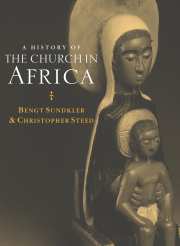Book contents
- Frontmatter
- Contents
- List of maps
- Acknowledgements
- List of abbreviations
- Introduction
- PART I THE FIRST FOURTEEN HUNDRED YEARS
- PART II THE MIDDLE AGES 1415 – 1787
- PART III THE LONG NINETEENTH CENTURY 1787 – 1919
- PART IV THE COLONIAL EXPERIENCE 1920 – 1959
- 11 Continental Panoramas
- 12 Local Perspectives
- 13 North and North-Eastern Africa
- 14 West Africa
- 15 Central Africa
- 16 Southern Africa
- 17 Eastern Africa
- PART V INDEPENDENT AFRICA 1960 – 92
- Notes
- Bibliography
- Name index
- Subject index
15 - Central Africa
from PART IV - THE COLONIAL EXPERIENCE 1920 – 1959
Published online by Cambridge University Press: 16 September 2009
- Frontmatter
- Contents
- List of maps
- Acknowledgements
- List of abbreviations
- Introduction
- PART I THE FIRST FOURTEEN HUNDRED YEARS
- PART II THE MIDDLE AGES 1415 – 1787
- PART III THE LONG NINETEENTH CENTURY 1787 – 1919
- PART IV THE COLONIAL EXPERIENCE 1920 – 1959
- 11 Continental Panoramas
- 12 Local Perspectives
- 13 North and North-Eastern Africa
- 14 West Africa
- 15 Central Africa
- 16 Southern Africa
- 17 Eastern Africa
- PART V INDEPENDENT AFRICA 1960 – 92
- Notes
- Bibliography
- Name index
- Subject index
Summary
CAMEROON
Politics
In the Church history of modern Africa a few concentrated periods of time seemed in a special way to indicate that the whole religious future of a country lay in the balance. For Buganda – together with the interlacustrine region as a whole – the years 1885–97 were such a period of suspense and re-orientation. The 1920s in Cameroon was another such period of compressed time. Prior to World War I, the beginnings of the Church's life had necessarily been tentative. Tucked away in isolated areas in the tropical forest, it was difficult to foresee what would result from that initial encounter with the Gospel. In the 1920s a Christian mass movement was to provide an overwhelming demonstration of the effect of that encounter.
Southern Cameroon rapidly grew to be a Christian country. In 1961, half the population there was registered as Christian, with 650,000 Catholics and 500,000 Protestants while over 70 per cent of the primary school age children attended school. For the Muslim north, the story was quite different. There, only one-tenth of the population were Christians. Politically, the Versailles Peace Treaty of 1919 made the Cameroon a mandated area under the League of Nations, divided between a western British and an eastern French region. The country's mandated definition served to remind the imperial powers – Britain and France – of the duty to prepare the country for independence.
- Type
- Chapter
- Information
- A History of the Church in Africa , pp. 750 - 785Publisher: Cambridge University PressPrint publication year: 2000



